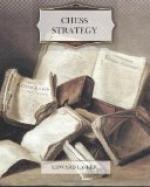--------------------------------------- 8 | | | | #R | | | #K | | |---------------------------------------| 7 | | | #Q | #R | #B | #P | #P | #P | |---------------------------------------| 6 | #P | #P | | #P | | | | | |---------------------------------------| 5 | | | #P | | | | | | |---------------------------------------| 4 | | | ^P | | ^P | ^B | | | |---------------------------------------| 3 | | ^P | | ^R | | | | | |---------------------------------------| 2 | ^P | | | ^Q | | ^P | ^P | ^P | |---------------------------------------| 1 | | | | ^R | | | ^K | | --------------------------------------- A B C D E F G H
Diag. 92
The last two diagrams exemplify this. If in Diagram 91 Black makes the mistake of playing P-QB4 as suggested, the backward QP becomes a welcome objective for White’s attack. White can keep that pawn back by playing P-Q B4 as soon as it threatens to advance, after which he would develop quietly, double his Rooks, and bring the Q and QB to bear in a concentrated attack on Q6. A position not unlike that in Diagram 92 will result ultimately, in which Black defends the pawn as many times as it is attacked, but in which White can bring up his KP to the attack, as the QP cannot move away, whilst Black has no further defensive move at his disposal. Play against a backward pawn nearly always develops on these lines, and is even easier when there is no defending B of the same colour as the pawn. (See p. 40, and Game No. 26.)
Such manoeuvres, in the course of which pieces are pinned and attacked, are illustrated in Diagram 90. The most obvious move, which initiates an attack and at the same time completes the development of the minor pieces, is B-Kt5. Attacks by means of such devices are so frequent and varied that it will be necessary to treat them at some length, which I now propose to do. I should also add that, with regard to Diagram 90, the student will derive lasting benefit from a thorough study of the position, and will thus improve his power to judge of the desirability, or otherwise, of obtaining open files, diagonals, doubled pawns, etc. After B-KKt5, the threat is to attack the Knight a second and third time with Kt-Q5, and Q-B3, after moving the KKt away. As Black’s KKt is only supported twice, and there is no chance of bringing up more forces for its defence, Black must undertake something to provide against the threatened onslaught.
The most natural plan is to develop the QB at K3, from where it can be exchanged for the Knight should Kt-Q5 be played. The doubled pawn, which White could force by exchanging the Bishops, is in no way detrimental to Black’s game. On the contrary, the opening of the file for the Rook, with the attendant chance of playing P-Q4 supported by the doubled pawn, gives Black the advantage.




